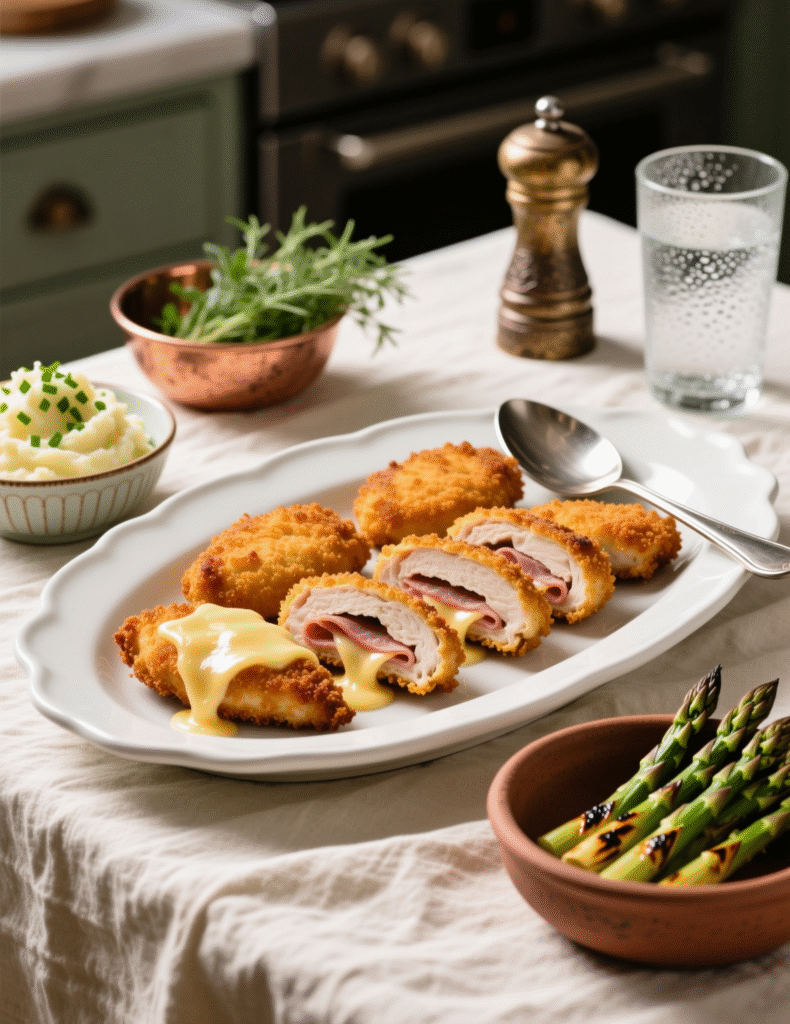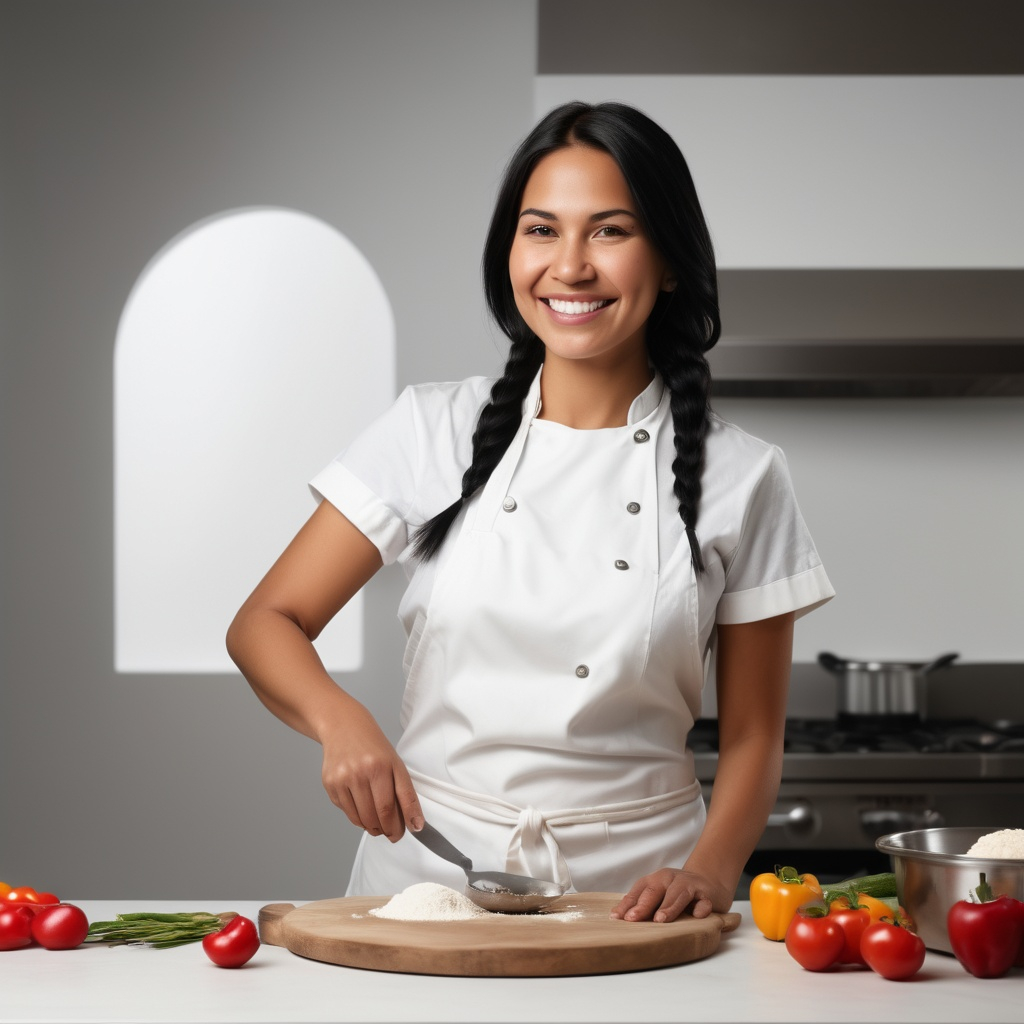Some dishes just have that magical mix of nostalgia, comfort, and elegance. Chicken Cordon Bleu is one of them. You cut through the golden crust, and there it is—the gooey cheese stretching, the savory ham tucked in neatly, the chicken still juicy instead of dry as cardboard. The name sounds fancy, almost intimidating, but this recipe is actually straightforward when you break it down properly. Today, we’ll walk through an easy Chicken Cordon Bleu recipe designed for 6 servings, while diving deep into the culinary science that makes this classic shine.
What Exactly Is Chicken Cordon Bleu?
Chicken Cordon Bleu is basically stuffed and rolled chicken breast breaded and fried (or baked). The “cordon bleu” phrase itself means “blue ribbon” in French, originally symbolizing culinary excellence. Though many assume it’s straight from French kitchens, history points to its modern version evolving in Switzerland during the 1940s or so. Think schnitzel got a makeover and suddenly decided to wear ham and cheese under its crispy jacket.
Professional kitchens have slightly different takes on this dish. Some stick with Gruyère cheese for authenticity, others swap in Swiss or even mozzarella if you want that melty pull. The ham is usually smoked or cured, but pros know mortadella or prosciutto can lend depth too. That’s the thing—cordon bleu is traditional, but it also begs experimentation.
Ingredients You’ll Need for 6 Servings
Let’s keep this precise. Professionals love exactness, but they also leave room for slight adjustments depending on texture and flavor.
- 6 boneless, skinless chicken breasts (each about 6–7 oz)
- 6 slices of deli ham (preferably smoked or honey-cured)
- 6 slices of Swiss cheese or Gruyère
- 1 cup all-purpose flour
- 2 large eggs, beaten
- 2 tablespoons milk
- 2 cups breadcrumbs (Panko preferred for crunch)
- 1 teaspoon garlic powder
- 1 teaspoon onion powder
- ½ teaspoon paprika
- Salt and pepper to taste
- 3 tablespoons unsalted butter (for richness)
- 2 tablespoons olive oil
Optional but recommended: Dijon mustard for brushing inside the chicken, plus a squeeze of lemon to finish.

Prepping the Chicken
Butterflying chicken breasts is where most home cooks mess up. You don’t slice all the way through; you’re making a pocket that folds open like a book. Then, gently pound them flat between plastic wrap until they’re even—about ¼ inch thick. Uneven thickness is your enemy here; it causes one side to overcook while the other still clings onto rawness.
Sprinkle with salt and pepper before stuffing. Seasoning isn’t just for the crust—it starts at the base. Professionals know seasoning layers create depth, not just surface saltiness.
Assembling the Roll
Lay the chicken out flat. Brush lightly with Dijon mustard (not mandatory, but it cuts through richness). Place a slice of ham, then the cheese on top. Roll tightly, tucking edges as you go. The tighter the roll, the less chance of cheese escaping like lava during cooking. Use toothpicks if necessary, though chefs often prefer kitchen twine for even binding.
At this stage, some cooks chill the rolls for 15–20 minutes. Why? Cold firm meat holds its shape better when coated and cooked, reducing leaks. It’s a simple restaurant trick that works wonders.
Breading the Professional Way
Classic three-step breading station is non-negotiable. Flour first, then egg wash, then breadcrumbs. Each layer serves a purpose. Flour dries the surface so egg clings. Egg creates the sticky glue for breadcrumbs. Breadcrumbs, seasoned properly, bring the crunch.
Pros often double-dip: egg → crumbs → egg → crumbs again. Double crust equals insurance against sogginess. Also, mix butter into your breadcrumbs before coating. That little fat infusion makes sure you get even golden color during baking, instead of pale patches.
Cooking: Frying vs. Baking
Here’s the eternal debate. Purists pan-fry in butter and oil, finishing in the oven. It gives the most flavor and texture contrast—crispy exterior, juicy center. But baking is easier for 6 servings, especially if you’re cooking at home.
If frying: heat 2 tablespoons butter + 2 tablespoons olive oil in a skillet over medium heat. Sear rolls until golden on all sides, then transfer to a 375°F oven for 15–18 minutes until internal temperature reaches 165°F.
If baking only: preheat oven to 400°F. Place breaded rolls on a greased rack over a baking sheet. Spray lightly with oil for color. Bake 25–30 minutes, checking doneness with a thermometer.
Either way, rest the chicken for 5 minutes before slicing. Resting locks juices inside instead of flooding your plate.
Why Cheese Leaks Out—and How to Prevent It
Every chef’s nightmare: you plate the dish, slice into it, and half the cheese has already escaped. This happens due to poor sealing, overstuffing, or high oven heat. Solutions? Keep filling modest. Chill rolls before cooking. Always place seam side down on the pan. And don’t crank oven beyond 400°F—cheese melts faster than chicken cooks if heat’s too aggressive.
Sauce or No Sauce?
Some argue cordon bleu stands alone. Others insist it screams for sauce. The classic companion is a velvety Dijon cream sauce:
- 1 cup heavy cream
- 2 tablespoons Dijon mustard
- 1 tablespoon butter
- Pinch of nutmeg
- Salt and white pepper
Simmer until slightly thick, then pour over slices. It elevates the dish from home-style dinner to restaurant plating. Some chefs also add a splash of white wine or chicken stock for balance.
Nutritional Profile
For those curious: one serving (with ham, cheese, breading, baked) averages about 500–550 calories, 38g protein, 28g fat, and 28g carbs. Frying bumps fat up by 3–5 grams per serving. It’s indulgent, yes, but surprisingly high in protein. Moderation is the only real secret here.
Common Mistakes to Avoid
- Overcooking chicken – Dryness is the fastest way to ruin this dish. Use a thermometer, don’t guess.
- Skipping seasoning – Chicken breast is bland by default. Every layer needs seasoning.
- Rushing assembly – Loose rolls fall apart. Take time to roll tight.
- Heavy breading – Too thick a coating can overwhelm filling. Balance is key.
- Ignoring resting time – Patience pays in juiciness.

Professional Tips for Perfect Cordon Bleu
- Use Panko breadcrumbs mixed with crushed cornflakes for next-level crunch.
- Lightly toast breadcrumbs before coating for extra nutty flavor.
- Wrap cheese in ham instead of layering separately; this keeps cheese from leaking out.
- Slice rolls diagonally when serving—it looks dramatic and highlights the layers.
- Pair with a crisp white wine (Chardonnay, Sauvignon Blanc) or even a light pilsner if serving casually.
Variations Worth Exploring
- Spinach Cordon Bleu – Add sautéed spinach inside for color and nutrients.
- Italian Style – Swap ham for prosciutto, cheese for mozzarella, drizzle with marinara instead of Dijon sauce.
- Smoked Gouda Version – Richer, smokier flavor, pairs beautifully with a honey mustard sauce.
- Air Fryer Method – At 375°F for 18–20 minutes, surprisingly close to fried texture with less oil.
Restaurants sometimes even make “Cordon Bleu Bites,” miniature rolled versions perfect for catering. Small tweaks create entirely different dining experiences.
Why This Dish Still Matters Today
Chicken Cordon Bleu has endured because it bridges worlds. It’s rustic yet refined. It uses everyday supermarket ingredients but transforms them into something that feels celebratory. For chefs, it’s a teaching dish—rolling technique, breading technique, heat control, sauce making—all in one recipe. No wonder culinary schools still use it as a training staple.
Home cooks, meanwhile, love it for its surprise factor. Cut into a roll and guests see more than chicken. They see effort, thought, a touch of artistry. That’s why it hasn’t vanished like so many retro dishes of the 1960s and 70s.
Serving Suggestions
Pair cordon bleu with roasted vegetables, garlic mashed potatoes, or even a light arugula salad. The dish itself is heavy; sides should balance rather than compete. A lemon wedge on the side does more work than you think—bright acidity cuts through richness.
For presentation, slice rolls at an angle, fan them on the plate, drizzle sauce in a zigzag. Even at home, plating matters. It elevates perception, and perception impacts flavor more than people admit.
Conclusion
An easy Chicken Cordon Bleu recipe for 6 servings isn’t just about feeding people—it’s about mastering technique while delivering comfort. Professionals know the balance of crispy crust, molten cheese, and juicy chicken is a lesson in culinary control. With the right prep, the right breading, and a little patience, you can achieve restaurant-quality results at home.
The biggest takeaway? Simplicity wins. Don’t overload with fancy tricks. Let the ham, cheese, and chicken shine under that golden crust. Cook it with intention, rest it with patience, and serve it with confidence. That’s the ribbon-worthy secret.
FAQs
What is Chicken Cordon Bleu?
It’s a breaded chicken breast rolled with ham and cheese, then baked or fried until golden.
Can I make Chicken Cordon Bleu ahead of time?
Yes, assemble and refrigerate up to 24 hours before cooking.
What cheese works best for Chicken Cordon Bleu?
Swiss or Gruyère are traditional, but mozzarella or Gouda also work.
Should I fry or bake Chicken Cordon Bleu?
Frying gives the crispiest crust, while baking is lighter and easier.
How do I stop the cheese from leaking out?
Roll tightly, seal well, and chill before cooking.
What sauce goes with Chicken Cordon Bleu?
A creamy Dijon mustard sauce is the classic choice.
How long should I bake Chicken Cordon Bleu?
Bake at 400°F for 25–30 minutes or until 165°F internal temp.
Can I use an air fryer for this recipe?
Yes, cook at 375°F for about 18–20 minutes.
Is Chicken Cordon Bleu healthy?
It’s indulgent but high in protein; baking reduces fat.
What sides go well with Chicken Cordon Bleu?
Light vegetables, mashed potatoes, or a crisp salad pair perfectly.

Marie Smith is a passionate recipe blogger, sharing easy, delicious, and creative culinary ideas that inspire home cooks to elevate everyday meals with flavor and simplicity.
